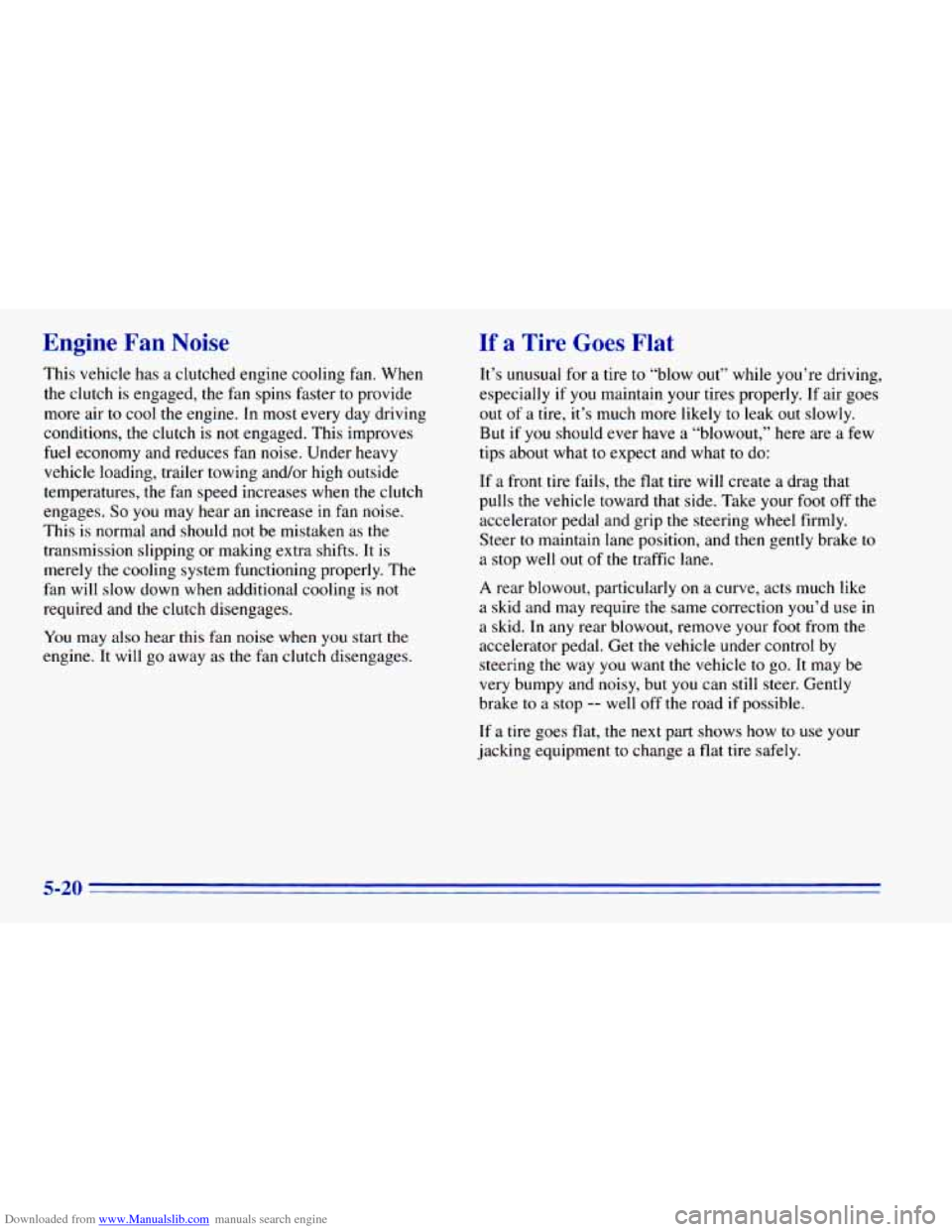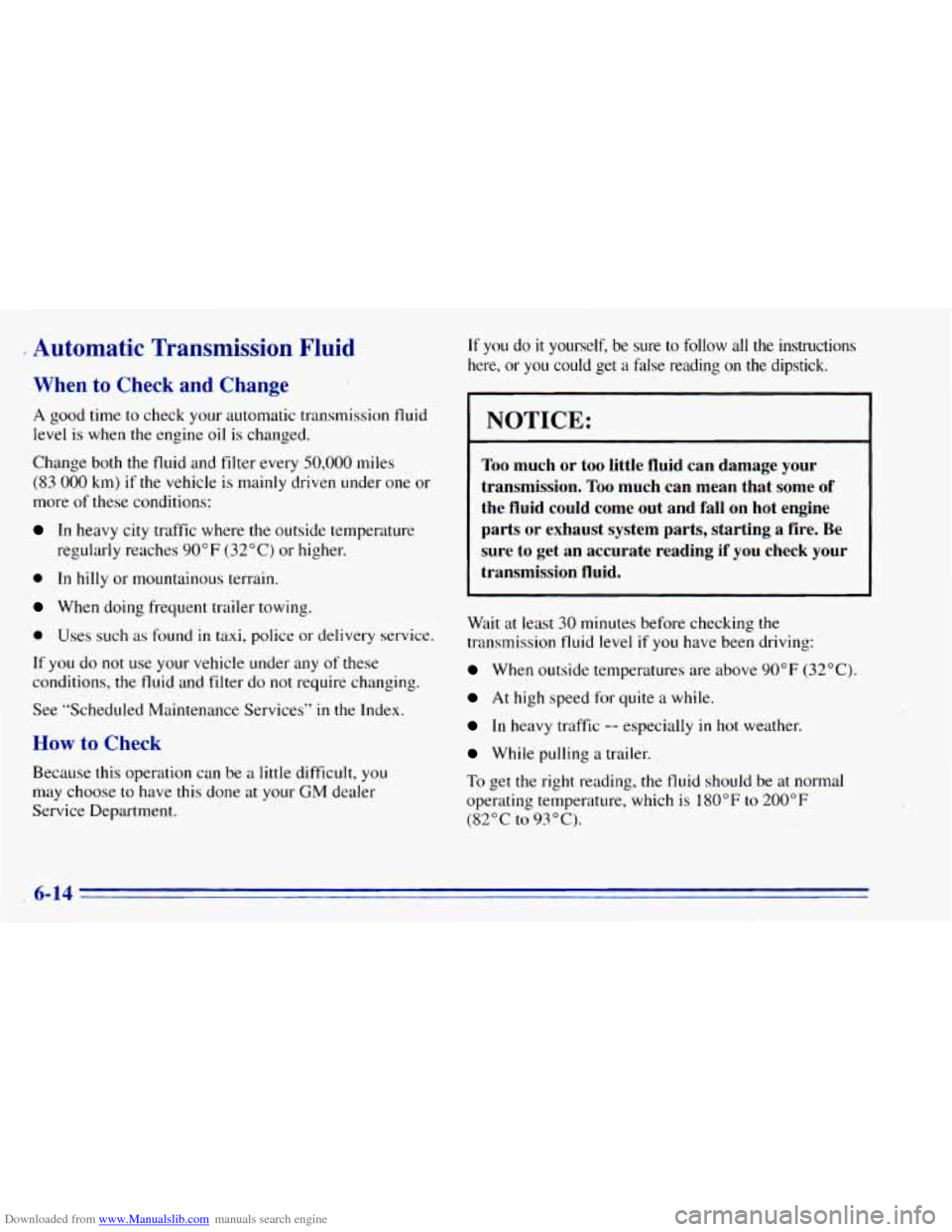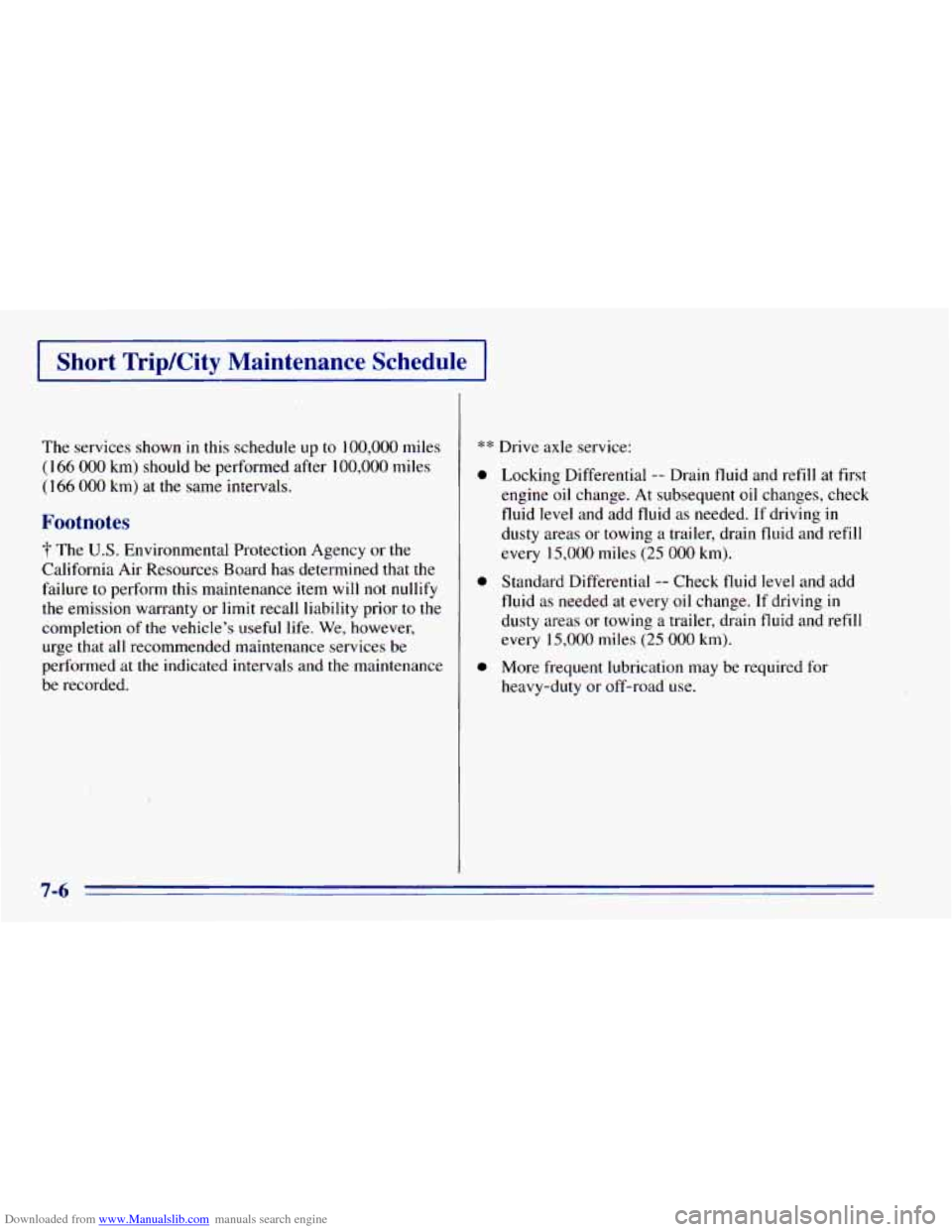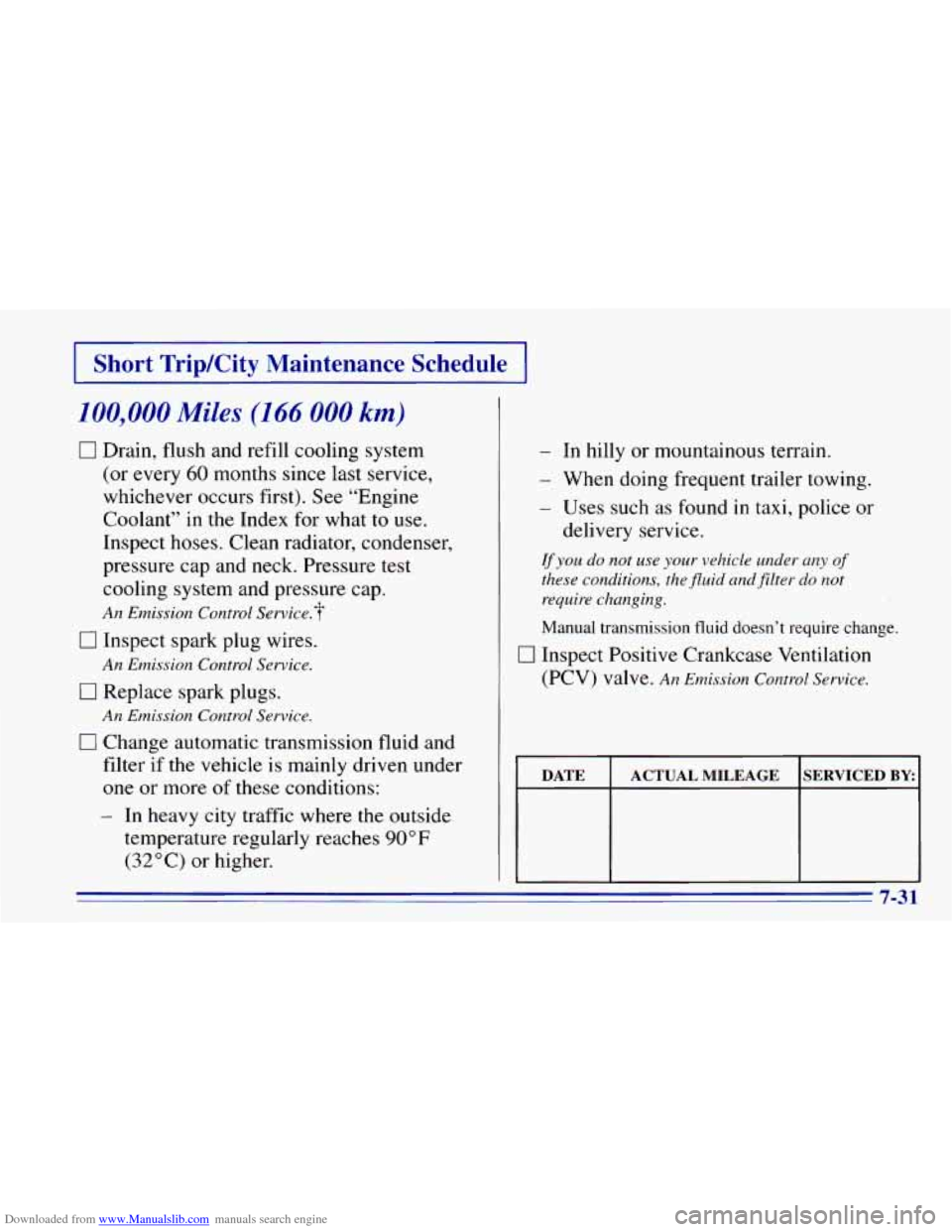Page 222 of 392
Downloaded from www.Manualslib.com manuals search engine Rear Towing
Tow Limits -- 35 mph (56 kh), 50 miles (80 km)
Vehicles with the all-wheel-drive or four- wheel-drive
option must use a towing dolly under the front
wheels
when towing from the real:
NOTICE:
Do not tow with sling-type equipment or rear
bumper valance damage will occur. Use wheel lift
or car carrier equipment. Additional ramping may be required for car carrier equipment. Use
safety chains and wheel straps.
Towing a vehicle over rough surfaces could
damage
a vehicle. Damage can occur from vehicle
to ground or vehicle to wheel-lift equipment. To
help avoid damage, install a towing dolly and raise
the vehicle until adequate clearance is obtained
between the ground and/or wheel-lift equipment.
Do not attach winch cables or J-hooks
to
suspension components when using car' carrier
equipment. Always use ,T-hooks inserted in the
T-hook slots.
Page 232 of 392

Downloaded from www.Manualslib.com manuals search engine Engine Fan Noise
This vehicle has a clutched engine cooling fan. When
the
clutch is engaged, the fan spins faster to provide
more air to cool the engine. In most every day driving
conditions, the clutch is
not engaged. This improves
fuel economy and reduces fan noise. Under heavy
vehicle loading, trailer towing and/or high outside
temperatures, the’ fan speed increases when
the clutch
engages.
So you may hear an increase in fan noise.
This is normal and should not be mistaken as
the
transmission slipping or making extra shifts. It is
merely the cooling system functioning properly. The
fan will slow down when additional cooling
is not
required and the clutch disengages.
You may also hear this fan noise when you start the
engine. It will go away as the fan clutch disengages.
If a Tire Goes Flat
It’s unusual for a tire to “blow out” while you’re driving,
especially
if you maintain your tires properly. If air goes
out of a tire, it’s much more likely
to leak out slowly.
But
if you should ever have a “blowout,” here are a few
tips about what to expect and what
to do:
If a front tire fails, the flat tire will create a drag that
pulls
the vehicle toward that side. Take your foot off the
accelerator pedal and grip
the steering wheel firmly.
Steer
to maintain lane position, and then gently brake to
a stop well out of the traffic lane.
A rear blowout, particularly on a curve, acts much like
a skid and may require the same correction you’d use in
a skid. In any rear blowout, remove your
foot from the
accelerator pedal. Get
the vehicle under control by
steering the way you want the vehicle
to go. It may be
very bumpy and noisy, but you can
still steer. Gently
brake to a stop
-- well off the road if possible.
If a tire goes flat, the next part shows how to use your
jacking equipment
to change a flat tire safely.
5-20
Page 234 of 392

Downloaded from www.Manualslib.com manuals search engine Removing the Spare Tire and Tools
The jacking equipment you'll need is stored along the
driver's rear wall. In some cases, you may have to
remove the spare tire
in order to reach the jack. Your
vehicle is also equipped with work gloves and
a plastic
ground mat to assist in the changing
of a flat tire.
To remove your jack cover,
pull up on the latch at the
end of
the cover, near the
endgate and the latch on the
top
of the cover. Remove
the wheel blocks, jack and
wheel wrench.
*
The following instructions explain how to remove
the spare tire, depending
on where it is mounted on
your vehicle.
NOTICE:
I
Never remove or restow a tire frodto a
stowage position under the vehicle while the
vehicle is supported by a
jack. Always tighten
the tire fully against the underside of the vehicle when restowing.
To remove the
underbody-mounted spare,
insert the chisel end
of the
wheel wrench, on an angle, into the hole in
the rear
bumper.
Be sure the chisel
end
of the wheel wrench
connects into the hoist shaft.
5-22
Page 246 of 392
Downloaded from www.Manualslib.com manuals search engine Rocking your vehicle to get it out:
First, turn your steering wheel left and right. That will
clear the area around
your front wheels. Then shift back
and forth between REVERSE (R) and a forward gear (or
with a manual transmission, between FIRST
(1) or
SECOND (2) and REVERSE(R)), spinning the wheels
as little as possible. Release the accelerator pedal while
you shift, and press lightly on the accelerator pedal
when the transmission is in gear.
If that doesn’t get you
out after a few tries, you may need to be towed out. Or,
you can use your recovery hooks if your vehicle has
them. If you do need
to be towed out, see “Towing Your
Vehicle” in the Index.
Using the Recovery Hooks
.“ .
Your vehicle may be equipped with recovery hooks.
The recovery hooks are provided at the front of your
vehicle.
You may need to use them if you’re stuck
off-road and need
to be pulled to some place where
you can continue driving.
i
5-34
Page 262 of 392

Downloaded from www.Manualslib.com manuals search engine .. Automatic Transmission Fluid
When to Check and Change
A good time to check your automatic transmission fluid
level
is when the engine oil is changed.
Change both
the fluid and filter every 50,000 miles
(83 000 km) if the vehicle is mainly driven under one or
more
of these conditions:
In heavy city traffic where the outside temperature
regularly reaches
90°F (32°C) or higher.
0 In hilly or mountainous terrain.
When doing frequent trailer towing.
0 Uses such as found in taxi, police or delivery service.
If you do not use your vehicle under any of these
conditions, the fluid and filter
do not require changing.
See “Scheduled Maintenance Services” in the Index.
How to Check
Because this operation can be a little difficult, you
may choose to have this done at your GM dealer
Service Department.
If you do it yourself, be sure to follow all the instructions
here, or you could get
a false reading on the dipstick.
I NOTICE:
Too much or too little fluid can damage your
transmission.
Too much can mean that some of
the fluid could come out and fall on hot engine
parts or exhaust system parts, starting a fire. Be
sure to get an accurate reading if you check your
transmission fluid.
Wait at least 30 minutes before checking the
transmission fluid level
if you have been driving:
When outside temperatures are above 90°F (32°C).
At high speed for quite a while.
In heavy traffic -- especially in hot weather.
While pulling a trailer.
To get the right reading, the fluid should be at normal
operating temperature, which is
180°F to 200°F
(82°C to 93°C).
. 6-14
Page 318 of 392

Downloaded from www.Manualslib.com manuals search engine Short TripKity Maintenance Schedule
The services shown in this schedule up to 100,000 miles
(1 66 000 km) should be performed after 100,000 miles
(166
000 km) at the same intervals:
Footnotes
The U.S. Environmental Protection Agency or the
California Air Resources Board
has determined that the
failure to perform this maintenance item will not nullify
the emission warranty or limit recall liability prior to the
completion
of the vehicle’s useful life. We, however,
urge that all recommended maintenance services be
performed at the indicated intervals and the maintenance
be recorded.
** Drive axle servic e:
e
e
0
Locking Differential -- Drain fluid and refill at first
engine oil change. At subsequent
oil changes, check
fluid level and add fluid as needed.
If driving in
dusty areas or towing a trailer, drain fluid and refill
every
15,000 miles (25 000 km).
Standard Differential
-- Check fluid level and add
fluid as needed
at every oil change. If driving in
dusty areas or towing a trailer, drain fluid and refill
every
15,000 miles (25 000 km).
More frequent lubrication may
be required for
heavy-duty or off-road use.
7-6
Page 330 of 392
Downloaded from www.Manualslib.com manuals search engine I Short TripKity Maintenance Schedule I
50,000 Miles (83 000 km)
0 Change automatic transmission fluid and
filter if the vehicle is mainly driven under
one or more
of these conditions:
- In heavy city traffic where the outside
temperature regularly reaches
90 O F
(32°C) or higher.
- In hilly or mountainous terrain.
- When doing frequent trailer towing.
- Uses such as found in taxi, police or
delivery service.
lfyou do not LW your vehicle under any of
these conditions, the fluid and filter do not
require changing.
Manual transmission fluid doesn’t
require change.
DATE SERVICED BY: ACTUAL MILEAGE
7-18
Page 343 of 392

Downloaded from www.Manualslib.com manuals search engine Short Trip/City Maintenance Schedule
100,000 Miles (166 000 km)
0 Drain, flush and refill cooling system
(or every
60 months since last service,
whichever occurs first). See “Engine
Coolant”
in the Index for what to use.
Inspect hoses. Clean radiator, condenser,
pressure cap and neck. Pressure test
cooling system and pressure cap.
An Emission Control Service. 3-
0 Inspect spark plug wires.
0 Replace spark plugs.
0 Change automatic transmission fluid and
filter
if the vehicle is mainly driven under
one or more of these conditions:
An Emission Control Service.
An Emission Control Service.
- In heavy city traffic where the outside
temperature regularly reaches
90 OF
(32°C) or higher.
- In hilly or mountainous terrain.
- When doing frequent trailer towing.
- Uses such as found in taxi, police or
delivery service.
Ifyou do not use your vehicle under any of
these conditions, the fluid andjilter do not
require changing.
Manual transmission fluid doesn’t require change.
0 Inspect Positive Crankcase Ventilation
(Pcv) valve.
An Emission Control Service.
7-31